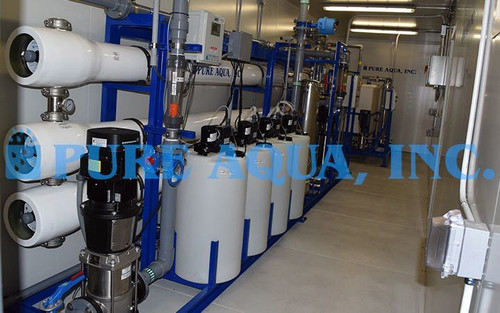Overview: These industrial reverse osmosis units were designed to treat well water and reduce TDS to supply a Resort in Guinea.
Industry: Resort/Hotel
- (6) FRP pressure vessels Protec rated at 300 PSI
- (18) 8" TFC spiral wound membranes Hydranautics CPA5-LDm high rejection membranes
- Pressure gauges as needed, (1) conductivity meter on product line and pH on product line, with ORP on feed line
- Low- & high-pressure switches
- (2) Flow meters for reject and product line
- High pressure pump CRN20-14
- 5-micron pre-filter with SS housing
- PLC control panel (Siemens S7-1200)
- All skids are SS304
- 2 systems located on the same skid as redundancy
- Chlorine analyzer to maintain chlorine level in the product tanks
These industrial RO systems were model #BW-130K-6380-5 from our RO-400 Series.
[custom-specifications]
Water Concern: The quality of water used in resorts and hotels drastically attributes to the overall quality of service and experience of the guests. Compared to hotels, resorts are known for having extraordinary service and water amenities like large pools and jacuzzies. However, with the feed source being derived from a well, the total dissolved solids (TDS) account is extremely high and must be treated in order to adequately provide these services. The well water contained 5,000 PPM TDS while the water quality required for these applications should be less than 20 PPM TDS. Therefore, a water treatment system would be required to supply purified water throughout the resort and elevate the quality of service and experience for the guests.
[/custom-specifications]
[custom-features]
Applied Solution: These industrial reverse osmosis units were recommended to reduce TDS of 5,000 PPM from well water for the application of a resort. The RO system consists of a six-stage process to efficiently and sustainably produce ultra-pure water. The process begins by perchlorinating the feed water to reduce the bio-fouling potential the water may have on the equipment. Secondly, the water is pumped through Multimedia filters to remove turbidity and reduce suspended solids present. Next, a green sand filter is supplied to remove the common elevated accounts of iron and manganese found in well water. Fourthly, the water passes through a carbon filter meant to target the removal of free chlorine and organics. Then, antiscalant dosing is injected into the water as it travels through the cartridge filters. Finally, the water is fed into the reverse osmosis system and separated by the membranes into two streams; reject and permeate streams. The permeate stream is then demineralized and the reject stream contains 99% of the initial Total Dissolved Solids (TDS).
[/custom-features]
[custom-usage]
Low operating cost, compact size, reduced footprint, and high quality production of freshwater.
[/custom-usage]
Industrial Reverse Osmosis Units for Resort (TDS Reduction) 2X 95,000 GPD - Guinea - Data Sheet[/custom-documents]
-
Great in our limited space facility.
We are satisfied with the RO system that we purchased as it has small footprint which is great in our limited space facility.
 ENGLISH
ENGLISH ESPAÑOL
ESPAÑOL العربية
العربية PORTUGUÉS
PORTUGUÉS FRANÇAIS
FRANÇAIS

















